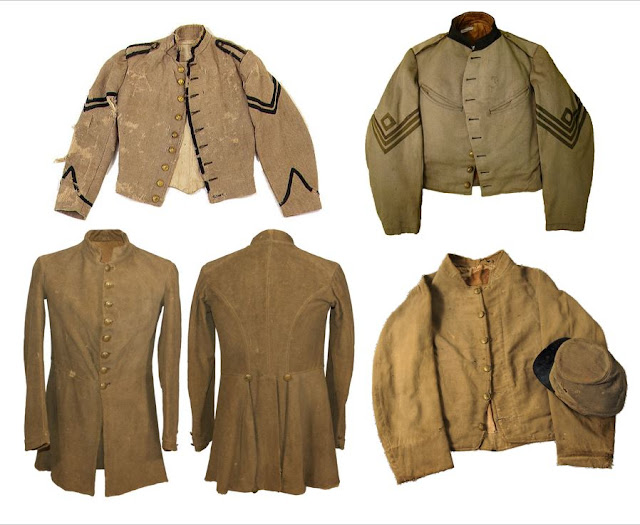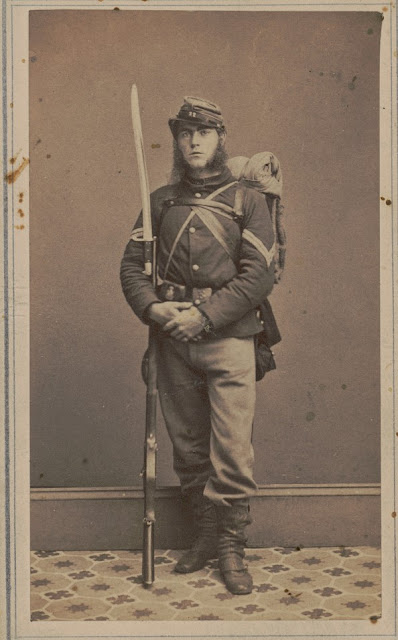Fair Play at Peach Tree Creek: An Account from the 22nd Wisconsin
"A critical moment had arrived."
The Federal armies under General William Tecumseh Sherman had advanced to the gates of Atlanta, and as the Army of the Cumberland approached the western approaches to the city, General John Bell Hood directed his first attack as newly appointed commander of the Army of Tennessee. The two armies would clash at Peach Tree Creek on the afternoon of July 20, 1864, and the 22nd Wisconsin found themselves in the front skirmish line when Hood's attack struck.
"The 22nd Wisconsin was ordered on skirmish and advanced across an open field which was divided by a deep ravine forming two parts or hills with the ground sloping toward the ravine gradually," one veteran noted. "The Rebels gave signs of uneasiness and soon advanced to the edge of the wood that bordered the field half a mile distant. Our line of battle was yet behind the high ground where it had first formed when word came that the Rebels were advancing. The 22nd Wisconsin held its line, skirmishing with the advancing foe. A critical moment had arrived. Our flank was in danger and could the Rebels have broken our line here, our whole force would have suffered awfully as an impassible creek was behind us and no woods to shelter our retreat. The 22nd was now pressed so hard that they could hold out but a short time."
The following account of Peach Tree Creek penned by a soldier in the 22nd Wisconsin writing under the pen name of Fair Play, first saw publication in the August 11, 1864, edition of the Saturday Evening Press from Menasha, Wisconsin.
Headquarters
Second Brigade, Third Division, 20th Army Corps
Three miles
from Atlanta, Georgia
July 21, 1864
Yesterday there was a general advance
of the whole army. The Third Division, 20th Corps crossed Peach Tree
Creek, a deep, narrow, and muddy branch running nearly east and west at 9 o’clock.
General Geary’s and General Williams’ division had crossed the day before. The
Third Brigade formed on the left and joined the 4th Corps, the 26th
Wisconsin being next to and on our left.
The 22nd Wisconsin was
ordered on skirmish and advanced across an open field which was divided by a
deep ravine forming two parts or hills with the ground sloping toward the
ravine gradually. The Rebels gave signs of uneasiness and soon advanced to the
edge of the wood that bordered the field half a mile distant. Our line of
battle was yet behind the high ground where it had first formed when word came
that the Rebels were advancing. The 22nd Wisconsin held its line,
skirmishing with the advancing foe.
A critical moment had arrived. Our
flank was in danger and could the Rebels have broken our line here, our whole
force would have suffered awfully as an impassible creek was behind us and no
woods to shelter our retreat. The 22nd was now pressed so hard that
they could hold out but a short time. The left of their line was already
flanked. The order came to advance. Quickly and silently the division moved
forward, onward and upward until the crest of the first hill was reached by the
Second Brigade in the advance of the First and Third. The 22nd
Wisconsin then fell back and formed in line. The Rebs came on en masse. Our
batteries on the right and left opened and followed by the roar of musketry
told the beholder that heavy work was being done.
The engagement was for a time
doubtful. Geary was pressed back. The First Division of the 4th
Corps was driven behind its third line. In our front, it was raging. Now our
men fell back to the ravine, having advanced once beyond, driving the Rebels,
who were reinforced by another line and came up on the double quick. Once in
the ravine, our center was protected from their fury, while the battery on our
right and also the one on our left mowed them down.
On they came down the slope when our men received them as
soldiers do. Like grain before the reaper they fell, filling the road and
covering the hillside. They wavered, then rallied and fired. Our line then
advanced and drove them back nearly half a mile and held them there. Ammunition
was brought up as our second line now had but 15 rounds to the man. The guns
were so hot that I saw many with their hands blistered by handling them. Had
the Rebels’ reinforcements come upon us, they could have driven us back. But so
severely had we punished them that they gave it up. Our line advanced and
captured the wounded.
About 300 of their killed lay upon our
ground and from 70-100 men, all severely wounded, who were brought in and laid
beneath some shade trees to wait their turn for transportation to our filled
hospitals. Our men were cared for first. The Second Brigade captured 200
prisoners and I am told that a great many were captured by other brigades of
this and other divisions. Just at dusk, when the fighting was still heavy,
General Sherman sent word that Schofield and McPherson’s armies had got to
within two miles of Atlanta in the Rebel rear. When this news was announced, a
shout arose that was distinctly heard above the din of battle. At 9 o’clock,
the firing ceased and the wounded heroes were cared for.
General Hooker complimented General
Ward for the conduct of his division and Colonel Coburn is complimented for the
conduct of his brigade. General Hooker, after learning what the 22nd
Wisconsin had done, praised its conduct and said no regiment ever did better
and that Colonel Bloodgood was deserving of great credit for his persistency in
holding his line so long. And he deserved it in behalf of the brave regiment he
commands.
Our regiment is quite small now, only
about 250 men for duty. The Rebels lost several field officers and the report
is current that General Hood was killed. Our men have been busy all day burying
the Rebel dead. Their loss is estimated at 25,000 killed and wounded in the
engagement. Our brigade lost 201 men killed and wounded. The 26th
Wisconsin lost severely and fought well. The 3rd Wisconsin was not
engaged. The 31st Wisconsin arrived here this morning in good health
and is assigned to the Third Brigade of the First Division.
There is some skirmishing on the lines today but no heavy firing. The 14th Corps on our right was not engaged much yesterday but there is an indication of a fight there as I write. Our wounded are all well cared for. Our lines are strengthened and we propose to whip out Mr. Johnny.
Yours in
haste,
Fairplay
To learn more about the Battle of Peach Tree Creek, please check out these other posts:
The Iron Game at Peach Tree Creek (73rd Illinois)
The Nicest Fight I Ever Saw: The 55th Ohio and Peach Tree Creek
Among the Provost Guards at Peach Tree Creek (79th Ohio)
Our Boys Went in with a Yell: At Peach Tree Creek with the 79th Ohio
Hooker's Finest Hour: With the 20th Corps at Peach Tree Creek (82nd Ohio)
With the 37th Mississippi at Peach Tree Creek
Source:
Letter from “Fairplay,”
22nd Wisconsin Volunteer Infantry, Saturday Evening Press
(Menasha, Wisconsin), August 11, 1864, pg. 3












Comments
Post a Comment